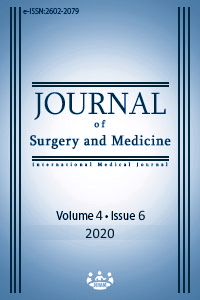Evaluation of scoliosis in patients with lumbosacral transitional vertebra
Keywords:
Lumbosacral transitional vertebra, Magnetic resonance imaging, Scoliosis, Psoas musclesAbstract
Aim: Lumbosacral transitional vertebra and scoliosis both have the potential to alter spinal balance, along with psoas muscles, which are important in the maintenance of spinal alignment. In this study we aimed to evaluate the relationship between lumbosacral transitional vertebrae and their potential influence on lumbar alignment.
Methods: In this cross-sectional study, lumbar Magnetic Resonance Imaging (MRI) studies that are referred to our Radiology Department between January 2017 and July 2017 were evaluated. 125 patients with lumbosacral transitional vertebra and 125 patients without any history of previous spinal surgery, trauma, inflammatory or infectious diseases were included. Type of transitional vertebra (unilateral/bilateral), presence of scoliosis and psoas muscle diameter-area measurements were evaluated.
Results: Among the transitional vertebra group, 75 patients had unilateral and 50 had bilateral sacralization. Among sacralization patients, 52.8% also had scoliosis. The presence of scoliosis was significantly lower in patients with bilateral sacralization compared to those with unilateral sacralization (P=0.001). The psoas muscle cross-sectional area and diameters were also further evaluated for the presence of asymmetry in the scoliosis group. Measurements were made twice by one radiologist and the mean value was used for statistical analysis. Results showed that area and transverse diameter asymmetries were statistically significant in patients with scoliosis (P=0.001 and P=0.003, respectively).
Conclusions: Lumbosacral transitional vertebra deteriorates spinal alignments and particularly when unilateral, may cause scoliosis and psoas muscle asymmetry. The pathophysiology of psoas muscle asymmetry, however, is controversial and should be further evaluated.
Downloads
References
Becker A, Held H, Redaelli M, Strauch K, Chenot JF, Leonhardt C, et al. Low back pain in primary care: costs of care and prediction of future health care utilization. Spine. 2010;35(18):1714–20.
Richard J. H., Asif S. Numbering of Lumbosacral Transitional Vertebrae on MRI: Role of the Iliolumbar Ligaments. AJR. 2006;187:59-66.
Gundogdu E. Rare and overlooked two diagnoses in low back pain: Osteitis condensans ilii and lumbosacral transitional vertebrae. J Surg Med. 2018;2(3):320-3.
Castellvi AE, Goldstein LA, Chan DPK. Lumbosacral transitional vertebrae and their relationship with lumbar extradural defects. Spine. 1984;9:493–5.
Almeida DB, Mattei TA, Sória MG, Prandini MN, Leal AG, Milano JB, et al. Transitional lumbosacral vertebrae and low back pain: diagnostic pitfalls and management of Bertolotti’s syndrome. Arq Neuropsiquiatr. 2009;67:268-72.
Paajanen H, Erkintalo M, Kuusela T, Dahlstrom S, Kormano M. Magnetic resonance study of disc de generation in young low-back pain patients. Spine (Phila Pa 1976). 1989;14:982-5.
Ashour R, Jankovic J. Joint and skeletal deformities in Parkinson's disease, multiple system atrophy, and progressive supranuclear palsy. Mov Disord. 2006 Nov;21(11):1856-83.
Aebi M. The adult scoliosis. Eur Spine J. 2005;14(10):925–48.
Danneels LA, Vanderstraeten GG, Cambier DC, Witvrouw EE, De Cuyper HJ. CT imaging of trunk muscles in chronic low back pain patients and healthy control subjects. Eur Spine J. 2000;9:266-72.
Nardo L, Alizai H, Virayavanich W, Liu F, Hernandez A, Lynch JA, et al. Lumbosacral Transitional Vertebrae: Association with Low Back Pain. Radiology. 2012;265:497-503.
de Bruin F, Ter Horst S, Bloem JL, van den Berg R, de Hooge M, van Gaalen F, et al. Prevalence and clinical significance of lumbosacral transitional vertebra (LSTV) in a young back pain population with suspected axial spondyloarthritis: results of the SPondyloArthritis Caught Early (SPACE) cohort. Skeletal Radiol. 2017;46:633–9. doi: 10.1007/s00256-017-2581-1
Panjabi MM. The stabilizing system of the spine. Part II. Neutral zone and instability hypothesis. J Spinal Disord. 1992;5:390-396; discussion 397.
Hyoungmin K, Choon-Ki L, Jin SY, Jae HL, Jae HC, Shin SI, Lee HJ, et al. Asymmetry of the cross-sectional area of paravertebral and psoas muscle in patients with degenerative scoliosis. Eur Spine J. 2013;22:1332–8. DOI: 10.1007/s00586-013-2740-6.
Dangaria TR, Naesh O. Changes in cross-sectional area of psoas major muscle in unilateral sciatica caused by disc herniation. Spine (Phila Pa 1976). 1998;23:928-31.
Wan Q, Lin C, Li X, ZengW, Ma C. MRI assessment of paraspinal muscles in patients with acute and chronic unilateral low back pain. Br J Radiol. 2015;88:20140546.
Downloads
- 1425 1586
Published
Issue
Section
How to Cite
License
Copyright (c) 2020 Tuba Selçuk Can
This work is licensed under a Creative Commons Attribution-NonCommercial-NoDerivatives 4.0 International License.
















